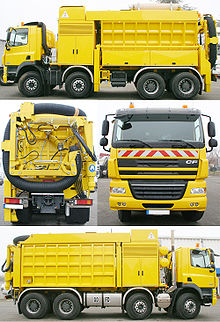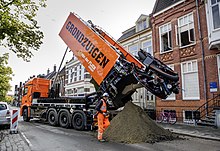This article has multiple issues. Please help
improve it or discuss these issues on the
talk page. (
Learn how and when to remove these template messages)
|

A suction excavator, or vacuum excavator, is a construction vehicle that removes heavy debris or other materials from a hole on land using vacuuming. Suction excavators are meant to be more non-destructive than regular excavators. [1] The suction excavator uses suction fans for the airflow to suck up the material that is then transported into the holding tank.
Hydro excavation, a type of suction excavator using high-pressure water jets, is sometimes referred to as daylighting, as the underground utilities are exposed to daylight during the process. [2] Some suction excavators also use an air filter.
History
Since 1993, RSP UK Suction Excavators Ltd. has produced suction structures mounted onto two, three, and four-axle vehicles, stationary suction units, and custom-made machines. [3] Pacific Tek, [4] also founded in 1993, has created the Angled Vacuum Excavator Tank (1997) and the 180° Swivel Mount Valve Operator (1999).
In 1998, the Mobile Tiefbau Saugsysteme produced another type of suction excavator. [5]
The global market size for suction excavators was estimated to be valued at US$924.7 million in 2020. [6]
Uses
Suction excavators are sometimes used for removing earth around buried utilities and tree roots. It can suck up liquids, e.g., water from a hollow. Typically, vacuum excavation loosens the soil with a blunt-nosed high-pressure air lance or water source and vacuums away loosened material.

Depending on the machine used and soil conditions, a 12-inch-square, 5-foot-deep pothole can be completed in 20 minutes or less. [7] Vacuum excavation is sometimes used in conjunction with conventional underground (one-call) locating services. Because of overlapping buried utility lines, locating devices often miss some of the buried utilities on a site and cannot completely or accurately mark a site.
According to New Mexico 811's (NM811) Aligning Change, Locating with Potholing, "One-call paint marks and flags are the first steps in making the process of locating underground utilities safer, the use of vacuum excavation technology adds an additional margin of safety." [8]
See also
- Dredging
- Gully emptier
- Street sweeper
- Suction dredger, used for dredging underwater
- Suction (medicine)
References
-
^ 365 vacex (10 July 2023).
"Everything You Need to Know About Suction Excavation". Medium. Retrieved 6 June 2024.
{{ cite web}}: CS1 maint: numeric names: authors list ( link) - ^ "What is Daylighting Excavation?". cloud-9-services. 16 September 2020. Retrieved 6 June 2024.
- ^ "History". RSP-Germany. Retrieved 24 June 2014.
- ^ "pacific-tek.com". pacific-tek.com. Retrieved 16 December 2014.
- ^ "MTS Suction Excavators". Retrieved 24 June 2014.
- ^ Saurabh Vijay, Samel; Mutreja, Sonia (October 2023). "Suction Excavator Market Size, Share, Analysis and Forecast 2023-2032". Allied Market Research. A12455. Retrieved 6 June 2024.
- ^ Griffin, Jeff. Underground Construction. Oildom Publishing, 2001.
- ^ 2009 New Mexico 811 Magazine. Published by ACTS Now, Inc.
External links
![]() Media related to
Suction excavators at Wikimedia Commons
Media related to
Suction excavators at Wikimedia Commons
This article has multiple issues. Please help
improve it or discuss these issues on the
talk page. (
Learn how and when to remove these template messages)
|

A suction excavator, or vacuum excavator, is a construction vehicle that removes heavy debris or other materials from a hole on land using vacuuming. Suction excavators are meant to be more non-destructive than regular excavators. [1] The suction excavator uses suction fans for the airflow to suck up the material that is then transported into the holding tank.
Hydro excavation, a type of suction excavator using high-pressure water jets, is sometimes referred to as daylighting, as the underground utilities are exposed to daylight during the process. [2] Some suction excavators also use an air filter.
History
Since 1993, RSP UK Suction Excavators Ltd. has produced suction structures mounted onto two, three, and four-axle vehicles, stationary suction units, and custom-made machines. [3] Pacific Tek, [4] also founded in 1993, has created the Angled Vacuum Excavator Tank (1997) and the 180° Swivel Mount Valve Operator (1999).
In 1998, the Mobile Tiefbau Saugsysteme produced another type of suction excavator. [5]
The global market size for suction excavators was estimated to be valued at US$924.7 million in 2020. [6]
Uses
Suction excavators are sometimes used for removing earth around buried utilities and tree roots. It can suck up liquids, e.g., water from a hollow. Typically, vacuum excavation loosens the soil with a blunt-nosed high-pressure air lance or water source and vacuums away loosened material.

Depending on the machine used and soil conditions, a 12-inch-square, 5-foot-deep pothole can be completed in 20 minutes or less. [7] Vacuum excavation is sometimes used in conjunction with conventional underground (one-call) locating services. Because of overlapping buried utility lines, locating devices often miss some of the buried utilities on a site and cannot completely or accurately mark a site.
According to New Mexico 811's (NM811) Aligning Change, Locating with Potholing, "One-call paint marks and flags are the first steps in making the process of locating underground utilities safer, the use of vacuum excavation technology adds an additional margin of safety." [8]
See also
- Dredging
- Gully emptier
- Street sweeper
- Suction dredger, used for dredging underwater
- Suction (medicine)
References
-
^ 365 vacex (10 July 2023).
"Everything You Need to Know About Suction Excavation". Medium. Retrieved 6 June 2024.
{{ cite web}}: CS1 maint: numeric names: authors list ( link) - ^ "What is Daylighting Excavation?". cloud-9-services. 16 September 2020. Retrieved 6 June 2024.
- ^ "History". RSP-Germany. Retrieved 24 June 2014.
- ^ "pacific-tek.com". pacific-tek.com. Retrieved 16 December 2014.
- ^ "MTS Suction Excavators". Retrieved 24 June 2014.
- ^ Saurabh Vijay, Samel; Mutreja, Sonia (October 2023). "Suction Excavator Market Size, Share, Analysis and Forecast 2023-2032". Allied Market Research. A12455. Retrieved 6 June 2024.
- ^ Griffin, Jeff. Underground Construction. Oildom Publishing, 2001.
- ^ 2009 New Mexico 811 Magazine. Published by ACTS Now, Inc.
External links
![]() Media related to
Suction excavators at Wikimedia Commons
Media related to
Suction excavators at Wikimedia Commons